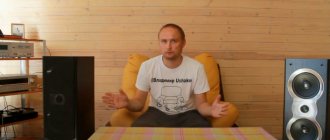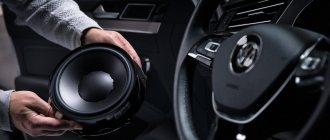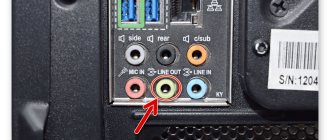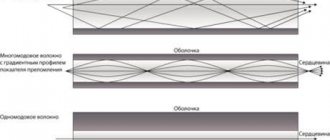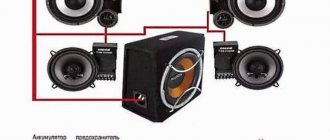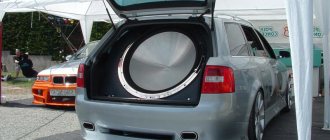Estimated reading time: 9 minute(s) And finally, hello! Today, as usual, we are finalizing the speaker system. Today it will be Eltax Hollywood acoustics.
I thought of starting to finalize the speaker system with explanations.
It’s worth a little understanding for those who don’t know what the concept of “two-way speaker system” means. What is hidden under such a concept as “two and a half stripes”. What is a “three-way system?” Are there acoustics with “three and a half bands”?
Examples of speaker systems for comparison
Basically, I have quite a few copies of columns for clarity. I will briefly try to talk about the differences and controversial concepts.
Elenberg SS 5062
Elenberg SS 5062
The first column is called Elenberg SS 5062. More precisely, that was the name before they were finalized. It has three speakers. Two MF / LF (mid-frequency / low-frequency), the third HF (high-frequency). But this is a “two-way” classic system, because the midrange/bass speakers play one band and they are absolutely the same. In theory, two mid/bass speakers play as one, the Crossover divides the sound into two bands.
Cortland 7000
Cortland 7000
Following the Elenberg is the Cortland 7000. It includes four speakers. These speakers play three bands. High-frequency, mid-frequency and two low-frequency speakers. Two LFs play one band. Experiments were carried out and an attempt was made to make “three and a half stripes” out of them. But since the woofers are the same, their resistance is also the same, but the resistance of the coils that cut off the frequencies is not exactly the same. They played inconsistently and it was decided to abandon this idea.
Cortland STH 5500
Cortland STH 5500
Next comes the Cortland STH 5500. Previously, a video was shot to improve this acoustics. Watch the first part here. From the factory, these speakers are “two and a half bands”, which are also reproduced by three speakers. In other words, one speaker plays high frequencies, one midrange/bass speaker, and one low frequency speaker plays pure lows. I would like to note that now they have become three-lane. They became a three-way system only so that they could play “correctly” with the Cortland 7000 speakers that are located at the front. Cortland STH 5500 are on the rear, rear and front center.
What changes occurred when the two-and-a-half system became a three-way system? First of all, the overall resistance of the column has changed. The nameplate says that these are “6 ohm” acoustics, but in fact, now it’s “10 ohm”.
What would you like to say about the speakers, in general?
How does a midrange speaker differ from a woofer? In appearance they are almost the same. Naturally, the diffuser material is different, but that’s not all. They have significantly different suspension rigidity. The softer the suspension, the lower the resonant frequency and, accordingly, the worse it plays midrange frequencies. Therefore, the subwoofer always has very soft speaker surrounds. Midrange speakers always have a hard suspension.
Eltax Hollywood
Eltax Hollywoodwood
The last specimen that will be discussed further is the Eltax from the Hollywood series. Today it will be finalized. This is a full-fledged “three-way” acoustics. It just has a huge tweeter. Two mid-range speakers. And on the side of the speaker there is another 8-inch speaker. It really has a very soft suspension. But if you think logically, then making a three-way speaker system out of such a shape is wrong!
A three-way system should look something like a Cortland STH 5500. All speakers should play forward. Here, it turns out that the woofer plays sideways. This performance is acceptable, but only if the speaker bandwidth is cut to stereo separation.” This is somewhere up to 300 hertz. But here it is unlikely that it is cut to 300 hertz.
CORTLAND STH-5500 cherry
Plushenko Pavel, 02/15/2016
Advantages: I bought only columns about them and a review on the secondary market. In terms of sound, oddly enough, cheap speakers have good mid frequencies, this is the merit of the Kevlar diffusers (yellow speakers), actually because of them I bought the speakers, the low frequencies are elastic, fast from 40Hz they start playing, and from 60Hz there is already good output for 5″ speakers good result. The front is made according to a 2.5 band system: (from top to bottom) HF, MF-LF in a separate box (BY) a partition between the speakers, and 3 only LF (FI). good sensitivity 89 dB, compared the sensitivity with the Sony SS-H701 speakers, they have 87 dB at the same volume level; these played noticeably louder, which means they didn’t lie in the characteristics. Center: the midrange is fine, the bass can even play from 60 Hz. Rear: the middle is the same, the bottom is only from 70Hz. Grills: low density fabric. The wiring is copper, but the cross-section seems to be 0.5mm.
Disadvantages: A huge minus, the high-frequency speakers in all speakers play up to 15000Hz, transparency is out of the question, they squeak something and that’s it, they spoil the whole scene. The HF speakers themselves are small magnets, a little more than 5 rubles in diameter and less thick. See. The second important minus is the isolation filters in the 2nd order fronts on the HF penny capacitor and the resistor and inductor coil. and on the induction coil. for each speaker, in the center and in the rear LF-MF speakers directly, and a HF capacitor and resistor. The actual power of the Fronts is no more than 70W, then they will burn out or the coil will break), the center is 60W, the rears are 35W. Assembly on 3 s +, the rear and center seemed to me to be poorly glued joints and the terminal, the glue inside the speakers was almost invisible. I fixed it with 1 large tube of Momet for wood. The front was glued quite normally, but almost the Phasics were peeled off, i.e. they were holding on. good, but you can pull it out by hand or by applying a power of 60-70W))). The speaker baskets are chrome, the faces will need to be painted. side in matte black. If you have no hearing, there are no disadvantages for you.
Comment: played with Pioneer VSX-529. due to the 89dB sensitivity on the receiver, it is enough to set the power to 15 out of 80 divisions for a comfortable volume (Sound Meter: Sound Meter on honor 6 showed 61dB at a distance of 2.5M) you can feel the bass on the sofa, if you turn it up to 45, you don’t need to buy a massager, only your neighbors I won't like the massager))). Speakers: HF all 6 Ohms, Front 5″ by 12 Ohms also with 4″ center connected in parallel 12+12=6 Ohms, rear 4″ 6 Ohms. There are plans to change the HF at the fronts, most likely with SEAS H0831-06 (27TFF) and a filter. So far I have replaced the wires in the center and rear with new ones. 2.5mm copper on the mid-bass speakers, and damped all the speakers with batting. If you are thinking whether to buy or not, if up to 5t. Ideally, it’s worth taking, as in my case for 2t. it turned out (the casing with minor abrasions, the main thing is that the speakers are like new) I had no doubt))) Especially against the backdrop of today’s prices for an analogue of 30,000, which will be no better even with its jambs. Frequency response rectification: 31Hz +10DB 63Hz 0DB 87Hz -2.2DB 125Hz -1.8DB 175Hz 0DB 250Hz 0DB 350Hz 0DB 500Hz 0DB 700Hz 0DB 1KHz 0DB 1.4KHz +1.8DB 2K Hz +1.6db 2.8kHz 0db 4kHz 0db 5.6kHz 0db 8kHz +5.6db 11.2 KHz +4.2dB 16KHz +10dB measured with a measuring microphone
Disassembling Eltax Hollywood acoustics
Right away, before starting disassembly, I’ll note that the sealing of the camera and 4-inch speakers is quite poor. This can be noticed by lightly tapping the cone of one midrange speaker. The other midrange speaker should oscillate slightly at this time. Air movement must be created inside the chamber. But it stands still, which means the air is escaping somewhere. We will definitely try to fix this.
A little about the large 8-inch speaker. Here the sealing is quite good, taking into account the fact that the bass reflex is currently locked into the table, or, in other words, the hole is plugged. We disassemble the speakers by unscrewing all the speakers from the housing.
Eltax Hollywood disassembly
There are quite a lot of self-tapping screws, so to make the work easier, you should use a screwdriver. Please note that the wires to the speakers are not soldered, but simple terminals are used, as when connecting speakers in a car.
The Eltax Hollywood acoustics have the most interesting part - the crossover. It should be there, and I wonder what it looks like. How it divides frequencies and what order the filters themselves are – let’s try to figure it out.
First order crossover, based on electrolytic capacitors. "Children's" filters! There is no other way to say it. The wire is thin enough for crossover coils, in my opinion, approximately 0.7mm. The first thought is “we need to make a two and a half lane crossover here”! What does it mean to make the low-frequency speaker cutoff at 200Hz. As it turned out, two 4-inch midrange speakers played from 0 to 3,500 Hertz.
After calculations, it turned out that the woofer plays up to 3000 Hertz! This is at first order crossover. In other words, it plays the whole – both low and mid frequency range! Midrange speakers play from 600 Hertz to 7000 Hertz. If he can play from 600 hertz, then he is probably not capable of playing up to 7000 hertz. The high-frequency spectrum from 7000 hertz should be played by a huge tweeter with a large magnet. Using some of the factory filters will not work. The technical characteristics of “standard” crossovers are such that there is no point in using parts from them. Let's try to correct the manufacturer's mistake.
Answers
Branching or even splitting is the key to sound.
It is very difficult to understand what you cut there, how you connected it, you can attach a photo or write more clearly. An active sub is connected in two ways and does not affect the power of the speaker. Try reading the instructions from your sub.
Could you please attach a diagram or photo of how you did it? And it’s not very clear from the description in words :))
Everything is very mixed up, you can’t hear other players in the sub? What was connected to what and how?
What amplifier? What is the subwoofer connected to? What are these old speakers?
It seems to me that you connected the sound directly to the sub. Not?
I re-read everything again - it seems that it is so.
TS - this subwoofer is not computer acoustics. You can't just connect it like that.
PS I would still like a photo of what happened.
What do the neighbors say? Have you consulted them? Maybe it's for the better that your subwoofer is not playing at full power?
Looks like the author of the question quietly disappeared :))
no, I'm here. These are the speakers. connected like this. To connect the speakers I bought 3.5 jack-2 tulips. I cut it and connected it to the clamps from above. I connected the wires from the speakers from below. in the photo (where the white one is connected) the sub does not work, one speaker works, the second does not work either. On the second one the sub doesn't work either, only one speaker works.
Yeah :)) As I wrote above, Cortland is not for a computer, but for a home theater. And the high output output is not the output from the subwoofer's amplifier, it's like bypassing HIS amplifier. You need the cheapest amplifier, which you connect to the linear output of your PC (minijack - two tulip wires). Then, from the output terminals of the amplifier, using an acoustic wire, connect the subwoofer to the high input. And then, using the same acoustic wire, from the high output output, connect the acoustics. You adjust the volume on the amplifier. Something like this :))
And finally, hello! Today, as usual, we are finalizing the speaker system. Today it will be Eltax Hollywood acoustics.
I thought of starting to finalize the speaker system with explanations.
We begin the first stage of preparing the columns.
We will seal them inside with padding polyester, purchased in advance and cut to the size of the column. We use regular PVA glue, which is sold in any hardware store. The size of the glue package is individual for the size of the speakers. For one pair of speakers of this size, one small can may well be enough.
As usual, I fill my column with padding polyester, as I expected. Anyone who has never filled their speakers with padding polyester will have a question - “why is it needed in the speakers?”
Everyone can verify the usefulness of padding polyester with their own hands and check it with their own ears. Try sealing one of the speakers and leaving the other as is - without damping material. And shout something loud into the open hole from the speaker. First in one column, and then immediately in another. The difference will be audible – no matter what! And you won’t have to prove anything and the question won’t arise.
Expensive brands always add synthetic padding to their acoustics. That’s why the sound quality in their acoustics is expensive.
The second stage of acoustics preparation.
We will make sure that the speakers do not ring. In this acoustic system, it turned out that all the speakers, from small to large, were very loud. It's easy to check. We take the magnet and tap the speaker basket with a screwdriver. Sounds like a saucepan. This does not add richness and beauty to the sound produced by the speakers.
In expensive acoustics, the speaker baskets are always thick and aluminum. This is done just to prevent them from ringing. We will seal the baskets with vibroplast remaining after denoising the car.
Third stage of improvement.
We can say that the most useless stage in refining an acoustic system is assembling the acoustic filter. So why is this the most useless activity in refining acoustics? Yes, because every second person says that this has absolutely nothing to do with sound quality. And for those who don’t think so, I recommend watching a video about assembling a crossover.
Link to video about crossover assembly
The assembly of the crossover is described there, and this one is assembled in exactly the same way. But the only difference is that empty tin coils for soldering served here as clips for the inductors. They are just perfect for this. Even with a core, it turns out that an iron pipe, half an inch, fits perfectly.
Reviews of CORTLAND STH-5500 cherry
Thank you, your review will appear on the site soon.
Home Cinema CORTLAND STH-5000 Characteristics Manufacturer USA Assembled in China General Speaker system type 5. 1 Russified menu Supported formats Audio MP3, WMA Video DivX, VCD, SVCD Media CD, DVD Number of loaded discs 1 Sound Signal-to-noise ratio 80 dB Equalizer Yes Equalizer presets 7 Decoders Dolby Digital, Dolby Pro Logic II Total power 900 W Front Placement Floor-standing Power 100 W Number of bands 3 Frequency range 42-20000 Hz Height 93.2 cm Width 16. 7 cm Depth 23. 8 cm Rear Placement Shelf Power 80 W Number of bands 3 Frequency range 42-20000 Hz Height 23.9 cm Width 13.9 cm Depth 14.5 cm Center Frequency range 80-20000 Hz Height 13.9 cm Width 40.2 cm Depth 14.5 cm Interfaces Composite input Yes S-Video Yes Analog stereo output Yes Equipment Remote control Color brown
The fourth stage, the last one.
We solder the wires to the connection terminals and attach the assembled crossovers to them. And we begin, directly, assembling an acoustic system called Eltax Hollywood. We insert the wires into the desired chambers. We solder the wires to the corresponding speakers and fix these speakers, each in its place. Where the wires enter the high-frequency chamber, we seal it with a piece of plasticine.
Characteristics of CORTLAND STH-5500 cherry
* Check with the seller for exact specifications.
Main characteristics
| Main unit | single block system |
| Main block color | silver |
| Speaker kit | 5.1 |
| Speaker color | cherry |
| Number of bootable disks | 1 |
Audio
| Speaker frequency range | 42-20000 Hz |
| Decoders | Dolby Digital, Dolby Pro Logic II, DTS |
| Equalizer | yes, 7 presets |
Video
| Progressive scan | There is |
Formats and media
| Supported media | CD, CD-R, CD-RW, DVD, DVD R, DVD RW |
| Supported Formats | MPEG4, VCD, SVCD, WMA, MP3, JPEG |
Acoustics
| Number of front speaker strips | 3 |
| Front speaker power | 80 W |
Interfaces
| Inputs | audio stereo |
| Exits | composite, S-Video |
Dimensions and weight
| Rear speaker dimensions (WxHxD) | 239x139x145 mm |
| Dimensions of the central channel (WxHxD) | 139x402x145 mm |
| Front speaker dimensions (WxHxD) | 932x167x238 mm |
* Check with the seller for exact specifications.
Summary
After finalization and assembly, of course, I listened to it. From experience I can say the following: Eltax from the Hollywood series is the worst acoustics I have ever come across!
First.
Initially, I didn’t like that the bass reflex in this acoustics was set to 100 hertz. It's something mumbling and screaming.
Second.
The midrange and bass speakers do not reach up to 3000 hertz at all, they scream loudly.
Third.
The only plus found is that the tweeter works well. It is not for nothing that it is the largest of the speakers. This means that the magnet on the speaker is large.


